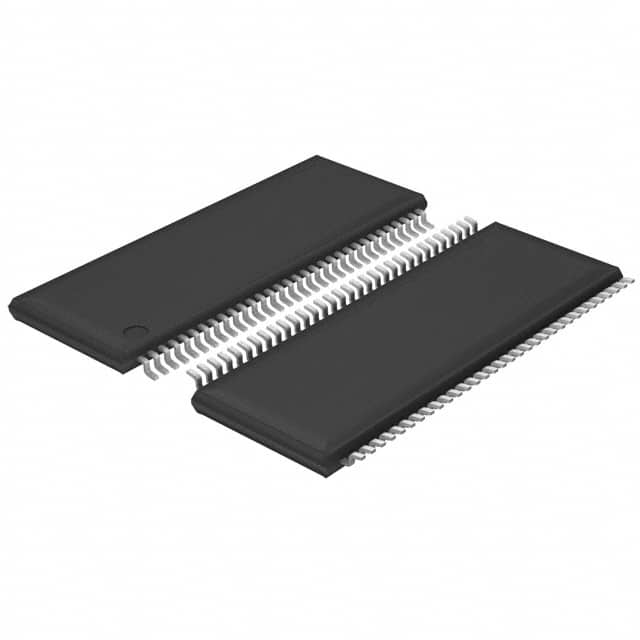Viz Specifikace pro podrobnosti o produktu.

SN74GTL16923DGGR
Product Overview
- Category: Integrated Circuit
- Use: Signal Level Translator
- Characteristics: High-speed, low-voltage, bidirectional translation
- Package: TSSOP (Thin Shrink Small Outline Package)
- Essence: Translates signals between different voltage levels
- Packaging/Quantity: Tape and Reel, 2500 units per reel
Specifications
- Supply Voltage Range: 1.2V to 3.6V
- Input Voltage Range (A Port): 0V to VCCA + 0.5V
- Input Voltage Range (B Port): 0V to VCCB + 0.5V
- Output Voltage Range (A Port): 0V to VCCA
- Output Voltage Range (B Port): 0V to VCCB
- Maximum Data Rate: 400 Mbps
- Number of Channels: 16
- Operating Temperature Range: -40°C to 85°C
Detailed Pin Configuration
The SN74GTL16923DGGR has a total of 56 pins, which are divided into various functional groups:
- VCCA and VCCB: Power supply pins for the A and B ports respectively.
- GND: Ground pin.
- OEAB and OEBA: Output enable pins for controlling the direction of translation.
- DIR: Direction control pin for selecting the translation direction.
- A1-A8 and B1-B8: Data input/output pins for each channel.
For a detailed pin configuration diagram, please refer to the datasheet provided by the manufacturer.
Functional Features
- Bidirectional Translation: Allows for seamless translation of signals between different voltage domains.
- Automatic Direction Control: The DIR pin determines the translation direction, simplifying the interface design.
- High-Speed Operation: Supports data rates up to 400 Mbps, enabling fast signal translation.
- Low-Voltage Operation: Works with supply voltages as low as 1.2V, making it suitable for low-power applications.
Advantages and Disadvantages
Advantages: - Wide supply voltage range allows compatibility with various systems. - Bidirectional translation simplifies the design of mixed-voltage systems. - High-speed operation enables efficient data transfer. - Small package size saves board space.
Disadvantages: - Limited number of channels may not be sufficient for complex applications. - Operating temperature range may restrict usage in extreme environments.
Working Principles
The SN74GTL16923DGGR utilizes a combination of level shifters and voltage translators to convert signals between different voltage levels. The DIR pin determines the direction of translation, while the OEAB and OEBA pins control the output enable function. The integrated circuit ensures bidirectional translation by automatically switching the direction based on the input signals.
Detailed Application Field Plans
The SN74GTL16923DGGR is commonly used in various applications, including:
- Communication Systems: Facilitates signal translation between different voltage domains in communication interfaces such as UART, SPI, and I2C.
- Industrial Automation: Enables seamless integration of devices operating at different voltage levels in industrial control systems.
- Consumer Electronics: Supports voltage translation in multimedia devices, gaming consoles, and portable electronics.
- Automotive Electronics: Provides level shifting capabilities for automotive communication protocols like CAN and LIN.
- IoT Devices: Allows for interoperability between sensors, microcontrollers, and wireless modules operating at different voltage levels.
Detailed and Complete Alternative Models
- TXB0108PWR: 8-bit bidirectional voltage-level translator with automatic direction sensing.
- PCA9306DCTR: Dual bidirectional I2C-bus and SMBus voltage-level translator.
- SN74LVC4245APW: Octal dual-supply translating transceiver with configurable voltage translation and 3-state outputs.
These alternative models offer similar functionality to the SN74GTL16923DGGR and can be considered based on specific application requirements.
Word count: 527 words
Seznam 10 běžných otázek a odpovědí souvisejících s aplikací SN74GTL16923DGGR v technických řešeních
Sure! Here are 10 common questions and answers related to the application of SN74GTL16923DGGR:
Q: What is SN74GTL16923DGGR? A: SN74GTL16923DGGR is a specific integrated circuit (IC) from Texas Instruments, which is a 16-bit universal bus driver with 3-state outputs.
Q: What is the purpose of SN74GTL16923DGGR? A: SN74GTL16923DGGR is designed to provide bidirectional buffering, level shifting, and voltage translation for various digital signals in technical solutions.
Q: What voltage levels does SN74GTL16923DGGR support? A: SN74GTL16923DGGR supports voltage translation between different voltage domains, typically between 1.2V and 3.3V.
Q: How many channels does SN74GTL16923DGGR have? A: SN74GTL16923DGGR has 16 channels, allowing it to handle multiple data lines simultaneously.
Q: Can SN74GTL16923DGGR be used for both input and output signals? A: Yes, SN74GTL16923DGGR can be used for both input and output signals, making it versatile for various applications.
Q: What is the maximum data rate supported by SN74GTL16923DGGR? A: SN74GTL16923DGGR can support data rates up to 400 Mbps, making it suitable for high-speed digital communication.
Q: Does SN74GTL16923DGGR have built-in ESD protection? A: Yes, SN74GTL16923DGGR incorporates built-in ESD protection, ensuring robustness against electrostatic discharge events.
Q: Can SN74GTL16923DGGR be cascaded to increase the number of channels? A: Yes, multiple SN74GTL16923DGGR ICs can be cascaded together to increase the number of channels as per the application requirements.
Q: What is the power supply voltage range for SN74GTL16923DGGR? A: SN74GTL16923DGGR operates with a power supply voltage range between 1.2V and 3.6V.
Q: Are there any specific application notes or reference designs available for SN74GTL16923DGGR? A: Yes, Texas Instruments provides application notes and reference designs that showcase the best practices and implementation guidelines for using SN74GTL16923DGGR in various technical solutions.
Please note that these answers are general and may vary depending on the specific requirements and use cases. It's always recommended to refer to the datasheet and documentation provided by the manufacturer for accurate information.

